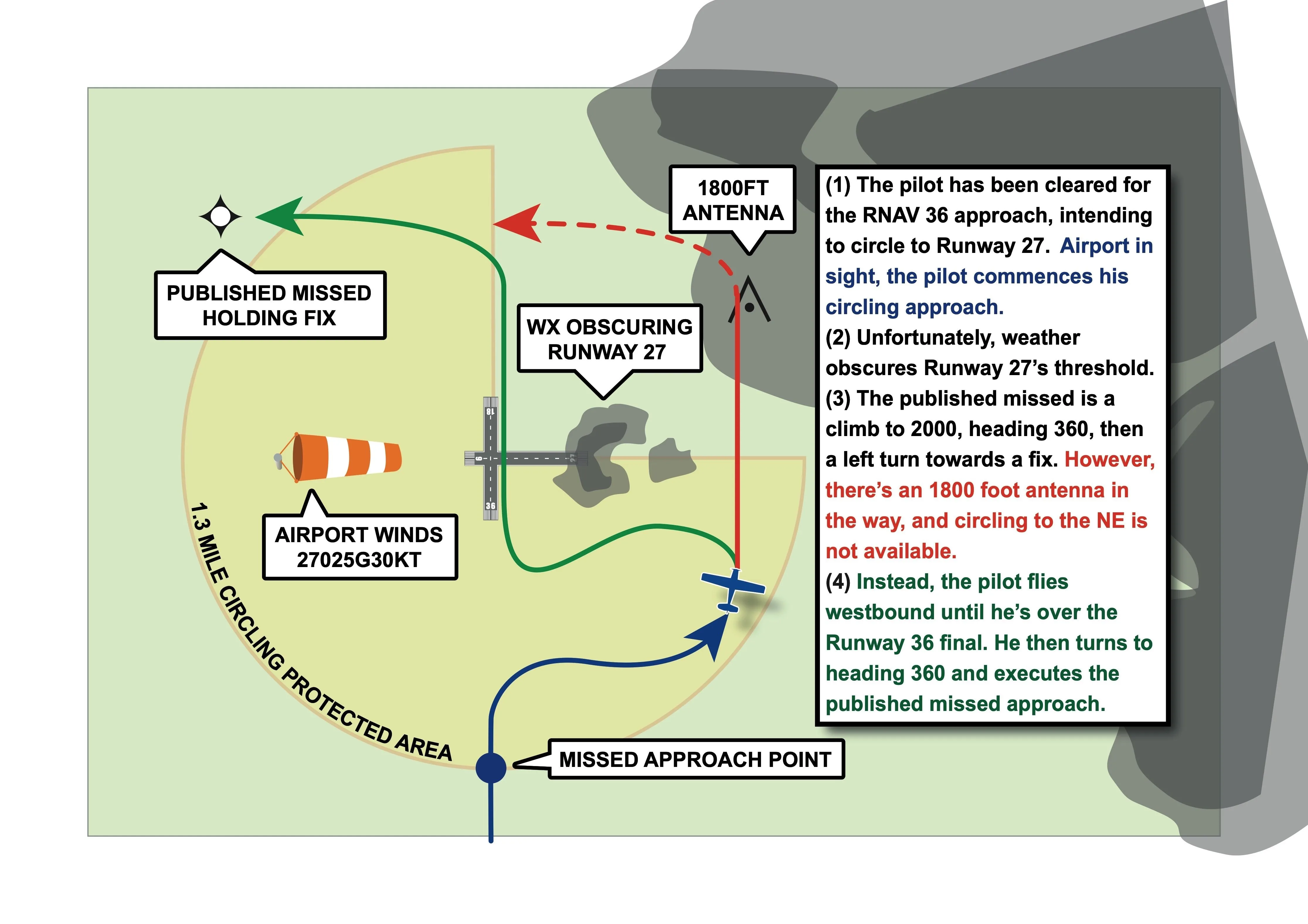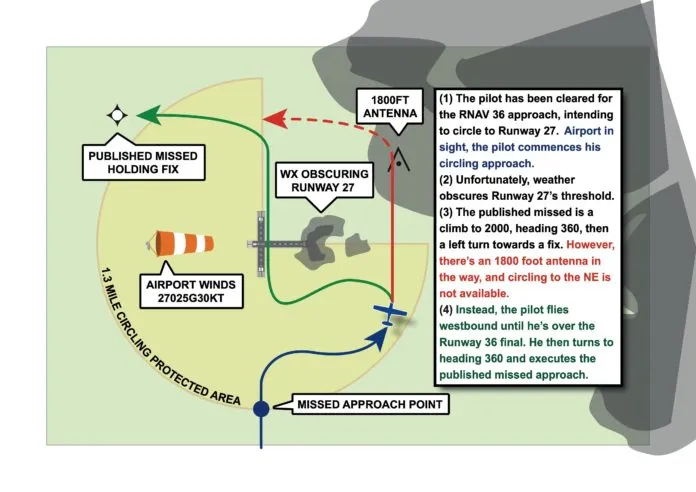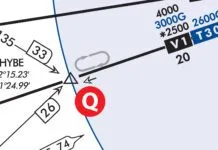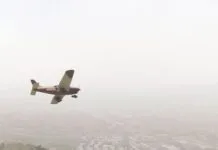Y ou’re ready to get home after a long cross country. Outside, it’s the kind of soggy, overcast day that begs for a Netflix couch binge under a blanket. Rivulets of rain slither across your windshield. It’s been nothing but bumps the whole way and you’re just drained.
Your home field is non-towered, and the AWOS says the winds are fierce out of the west. If it was VFR, Runway 27 would rock. However, there’s nasty precipitation starting five miles east of the airport. The RNAV 27 approach would drive you right through it. You’ve already been beaten up enough for one day. Instead, the reported 800 foot ceiling inspires you request an RNAV approach to Runway 36 with a circle to Runway 27. The circling mins are 600 feet for your aircraft category. You’ll stay close to the airport and once you get underneath, you can bring it around to land into the wind on 27.
You tell Approach your intentions. ATC clears you for the RNAV approach to Runway 36. (Reminder: at a non-towered airport, ATC only clears you for the named approach, not to circle to a specific runway. You choose the runway of intended landing.) You fly the approach and pop below the cloud bases. Airport in sight. You start your circle.

However, things are not as cut and dry as you hoped. As you arc right, you realize the bases are ragged. A descending swath of cloud is obscuring Runway 27’s threshold and the intensifying rain is killing visibility. Doubts are already filling your head when you hit a wicked pocket of turbulence and shear. As you struggle with your aircraft, you realize the universe is telling you it’s time to go missed.
If you were flying the RNAV 36 approach straight-in, the published missed is right there on the chart. Climb north to a specified altitude. Turn left to a fix and hold in a specified direction. But all that’s from an established path, not a circle. You’re off the rails now, far away from the RNAV 36 final approach course. What are your options?
Swinging Around
As an air traffic controller, I’ve been issuing circling approaches for years. During my initial radar training, I was told that published missed approaches didn’t apply to circling approaches. And whenever I issued a practice circling approach, I was taught to always provide a climbout heading and altitude to fly upon its completion. But what about unplanned missed approaches from a circle? ATC is all about following stacks of rules, but nowhere in the ATC book—FAA Order 7110.65—did it say anything about this.
It took some digging before I found AIM 5-4-21.h. explaining what pilots should do in the event of a miss during a circle. That section opens with a warning: “If the aircraft initiates a missed approach at a point other than the missed approach point… from below MDA or DA (H), or on a circling approach, obstacle clearance is not necessarily provided by following the published missed approach procedure, nor is separation assured from other air traffic in the vicinity.”
An approach gives us guidance to the runway while clearing obstructions by telling us to cross certain points at certain altitudes. As a vital segment of the entire approach, the published missed must also be certified for obstruction clearance from any established missed approach point (MAP). If you descend to the circling minimum descent altitude (MDA), cross the MAP, and can’t see the airport, you execute the published missed.
However, once you start circling, the MAP is history. Approach designers can’t possibly make a dedicated procedure for every point on the circle. Some protection for that infinite variety is provided by staging the circling altitudes well above obstructions in an airport’s immediate vicinity. They will also state in the procedural notes that circling approaches aren’t available to certain runways and/or from certain directions or at specified times of day.
Traffic is another factor mentioned in 5-4-21.h. Now, ATC shouldn’t be allowing another IFR aircraft to get near a circling aircraft, since there’s no guarantee how far the circle will go. Sure, the different categories have mileage restrictions, but it doesn’t always play right in real life. One Cessna 172 I worked—a category A, who was supposed to keep his circle inside of 1.3 miles—swung out to three miles. Thankfully, all of my other traffic was at least 1000 feet above him or far away laterally.
Given that there are limitless variations for where you could go missed during a circling approach, how are they addressed?
Getting Guidance
The first option is the most straightforward: contact ATC. From 5-4-21.h.: “In the event a balked (rejected) landing occurs at a position other than the published missed approach point, the pilot should contact ATC as soon as possible to obtain an amended clearance.”
Are you circling at a towered airport? Simply tell Tower you’re going around. Tower controllers know their surrounding obstructions, and will assign you an initial safe heading and altitude to fly away from traffic, terrain, and obstacles. After coordination with their overlying radar facility, they might amend your clearance to something more advantageous for resequencing.
In our earlier scenario, however, you’re missing at a non-towered airport. Contact the approach control or center that cleared you for the approach and notify them as soon as practical. “Approach, N123AB is missing off the RNAV 36, circle 27.” ATC should remember they need to provide an amended clearance. If not, just ask, “Request missed approach guidance.”
Often, if the weather is already sketchy at the destination airport, ATC may have already gotten ahead of things. The other day I had a Citation flying into a non-towered airport with weather moving in. Before clearing him for the RNAV approach, I told him, “In the event of a missed approach, enter controlled airspace [heading], maintain [altitude], and return to this frequency.” That way, he and I had matching expectations.
Of course, you’re absolutely welcome to ask ATC for custom missed approach instructions beforehand as well. Plain English works just fine. “Approach, N123AB, if I miss on the circle, what are your missed approach instructions?” However the message gets across, we’ll give you instructions to fly away from obstructions and other traffic.
On Your Own
You flick over to Approach’s frequency and reach out. No one answers. Uh oh. At the circling altitude, you might be below radio coverage. AIM 5-4-21.h. addresses this too. “Should a missed approach become necessary when operating to an airport that is not served by an operating control tower, continuous contact with an air traffic facility may not be possible. In this case, the pilot should execute the appropriate go−around/missed approach procedure without delay and contact ATC when able to do so.”
Exactly what is an appropriate go-around/missed approach procedure? “If unable to contact ATC for any reason,” 5-4-21.h. states, “the pilot should attempt to re−intercept a published segment of the missed approach and comply with route and altitude instructions.”
You’re currently in some weird no-man’s land, and the AIM is saying you should attempt to join a published segment of the missed approach. While sensible on paper, doing so isn’t always that easy.
Say the first part of the published missed for Runway 36 is a straight ahead climb—heading 360—to 2000 feet, then a westerly turn towards a fix while climbing to 3000. Okay. However, because you swung out east for the circle, you’re miles away from where that missed approach would normally commence. Will a turn to 360 be safe?
Here’s where I’m going to make a huge disclaimer: every airport environment, approach, and weather situation is so different, it’s impossible to say what will work at each one. You’ll need to maintain situational awareness and quickly assess what specific options and threats are present at that moment.
Are there obstacles, like antennas and buildings? Terrain? Is there severe weather? A huge clue is in the approach chart’s procedural notes—which you briefed carefully, of course. Here they say, “Circling NA northeast of RWY 27.” Considering you’re on a wide left base for 27, you could be headed into trouble.
A glance at the plan view shows a massive 1800 foot antenna two miles north of the 27 final. As this is your home field, you’ve seen it a hundred times. Now, with low visibility and ceilings, all you know is it and its deadly support wires are somewhere in the murk off your nose. A 360 heading from your current position takes you right at it—a terrible idea.
Instead, you backtrack, flying west over the runway as best as you can tell. When you hit the final approach course for Runway 36, you turn to 360 to track it outbound and continue climbing. That’ll put you back on a known track, away from the spire of doom. Nearing 2000 feet, you try ATC again. They answer. You say you’re missing and request further instructions.
Get Up and Get Down
How do other outcomes play out? What if intercepting the published missed approach isn’t possible? Could you try to land again? That is also answered in 5-4-21.h.: “If unable to contact ATC, and in the pilot’s judgment it is no longer appropriate to fly the published missed approach procedure, then consider either maintaining visual conditions if practicable and reattempt a landing, or a circle−climb over the airport.”
What if you went around due to something more benign than severe weather? Instead of our scenario’s angry tempest, imagine it’s just a simple 800-foot overcast. As you are about to land, though, a deer steps on to the runway and stops, entranced by your landing light. Not wanting to kill the deer—or your airplane—you go around.
If visual conditions can be safely maintained, you could circle around and try another landing, hopefully minus the four-legged speedbump. Remember: ATC cleared you for an approach to the airport, not a specified runway. You can land on another runway, or circle back to the same one. Until you land, declare a missed approach, or cancel IFR, the airport is all yours. No other IFR traffic will be cleared in.
Back to where changing to a different runway isn’t feasible. Runway 36/18’s crosswinds well exceed your limits, 27’s threshold is hidden by weather, and tailwind rules out Runway 9. Reattempting a landing is a no-go. On top of that, let’s say more weather and obstructions stand between you and the missed approach procedure.
Here’s where the final option applies: “circle−climb over the airport.” What would be a good altitude goal for this? A recommendation would be whatever altitude is used for the IAF. The missed approach procedure final altitude, if it’s higher than the IAF’s, could be a bad idea directly over the airport.
Why? To protect for your approach, ATC keeps the first 1000 feet above the IAF on the arrival side and directly over the airport free of IFR traffic. If the IAF is 2600, we wouldn’t let anyone go below 3600 directly over the airport. However, if the missed’s final altitude is 4000, you risk climbing into IFR traffic running directly over the airport at that (assumed to be available) altitude.
While you’re climbing, keep trying to contact ATC. A go-around on a circling approach leaves a lot of grey area, and the sooner you communicate your intentions with us controllers, the sooner we can help.
Knocked Senseless
I was recently vectoring a Falcon 2000 corporate jet for an RNAV approach at a non-towered airport. It was a rough weather day with numerous pockets of turbulence throughout our airspace.
I described the numerous thunderstorms bracketing the airfield and asked the Falcon pilot’s intentions. He opted to continue with the original approach, but circle to a different runway. However, sounding a bit unsure, he did ask about the weather at some of our neighboring airports. I told him they all were marginal to good VFR, far better than the convective cacophony awaiting him. One was just 10 miles north of his destination.
“Everyone’s getting in fine elsewhere,” I told him. “Advise if you would like to divert to another destination, or if you want delay vectors until the weather passes.” He wanted to press on. Okay, I tried, I thought. So, I cleared him for the approach, gave him an update on the weather that was encroaching on the airport, and changed him to advisory. I watched him fly the course, swing snugly around the airport, and drop off my scope at the airfield.
On the ground, he called to cancel IFR, clearly sounding rattled. On top of trying to cut the circle way too short to stay out of the weather, they’d been slammed by severe turbulence on short final. Objects were flung about the cabin, all over their passengers. “I wouldn’t recommend anyone attempt landing here,” he said. I was glad there were no injuries, but couldn’t help thinking he’d been given several outs, and chose none of them.
As it says in AIM 5-4-20.f., “Circling may require maneuvers at low altitude, at low airspeed, and in marginal weather conditions. Pilots must use sound judgment, have an in-depth knowledge of their capabilities, and fully understand the aircraft performance to determine the exact circling maneuver since weather, unique airport design, and the aircraft position, altitude, and airspeed must all be considered.”
All ATC can do is provide information and options. If you need more than we’re giving, please ask, and we’ll do our best: weather, NOTAMs, PIREPs, whatever you need. We can also recommend courses of action. Ultimately, though, regardless of whatever we tell you, it’s your call as the pilot to act on the information. —TK
When circling approaches go awry, Tarrance Kramer plays it straight while working traffic in the Midwest.






As NBAA’s representative on the FAA’s Aeronautical Charting Meeting, I was a part of the drafting of this AIM guidance: https://www.faa.gov/sites/faa.gov/files/about/office_org/headquarters_offices/avs/Hist%252007-01-272.pdf
You ask a question, what is an “appropriate missed approach”? The FAA answered this question back in 1982 with the rule change that included the statement “appropriate missed approach”. It is any missed approach procedure, and it does have to mean the published missed approach. In fact, in the final rule, the FAA specifically stated that the published approach may not be an appropriate missed approach procedure when the aircraft has passed the missed approach point. Any procedure, including the ODP or an engine failure takeoff procedure could be used as an “appropriate missed approach”. Some earlier drafts of this AIM guidance were more specific, but because air traffic concerns, it was watered down to its current version (see link to the history document). It is rare that a missed approach occurs beyond the missed approach point, but if it does, the 19.175 authorizes the pilot to fly “an appropriate missed approach” that avoids obstacles. If he/she is flying a missed approach other than published missed approach, they need to tell ATC as soon as practicable.